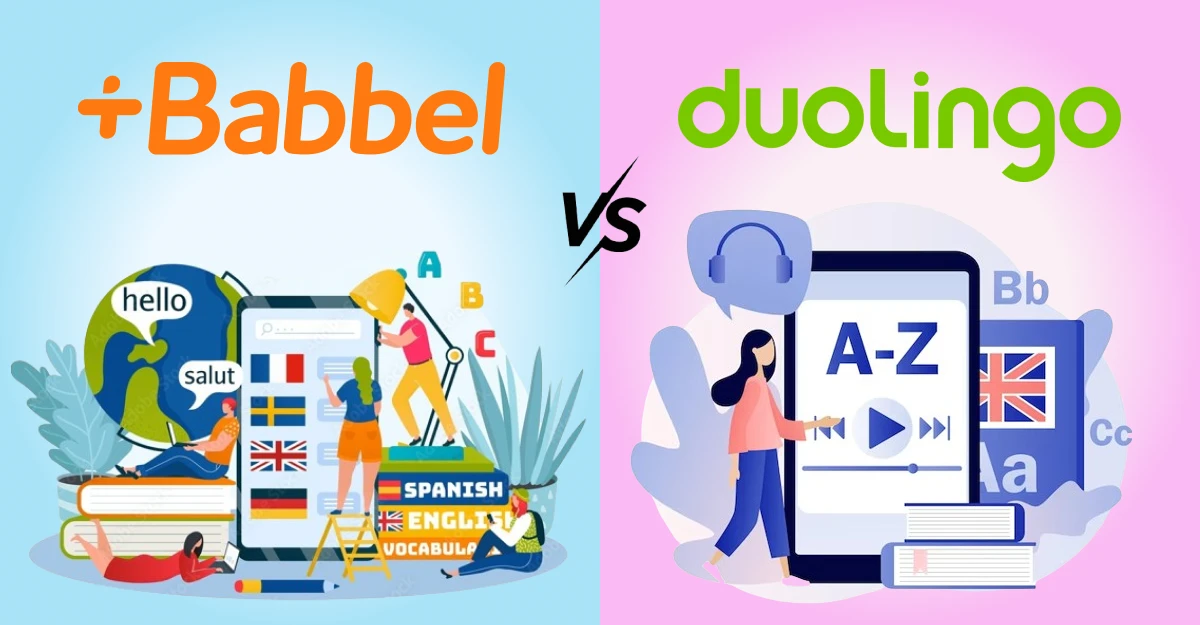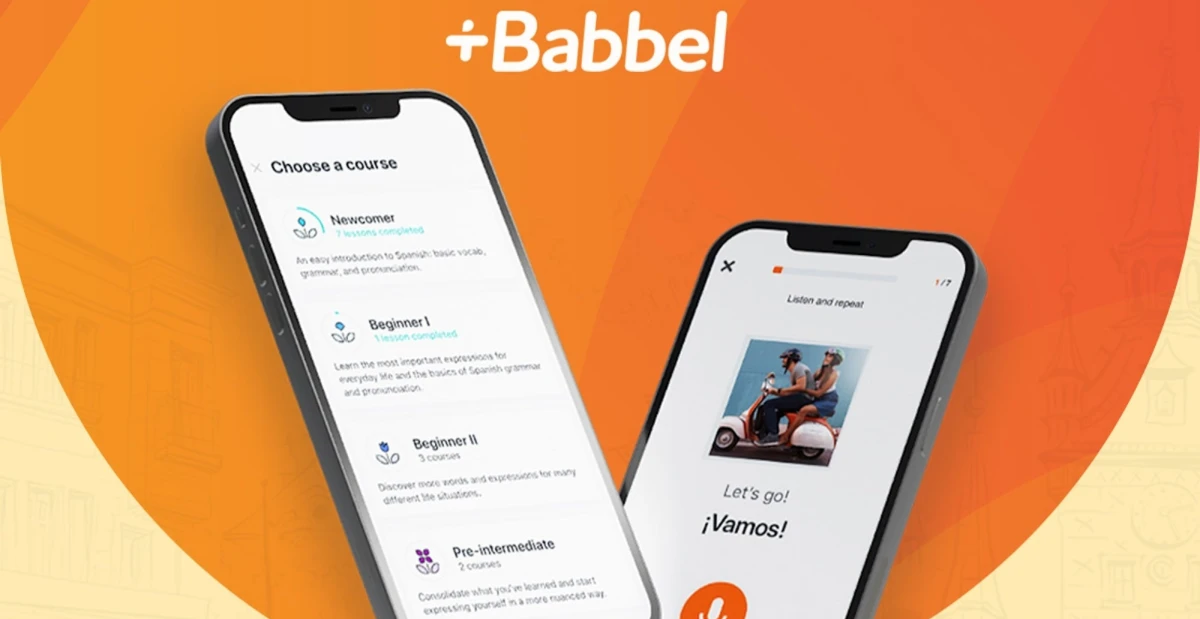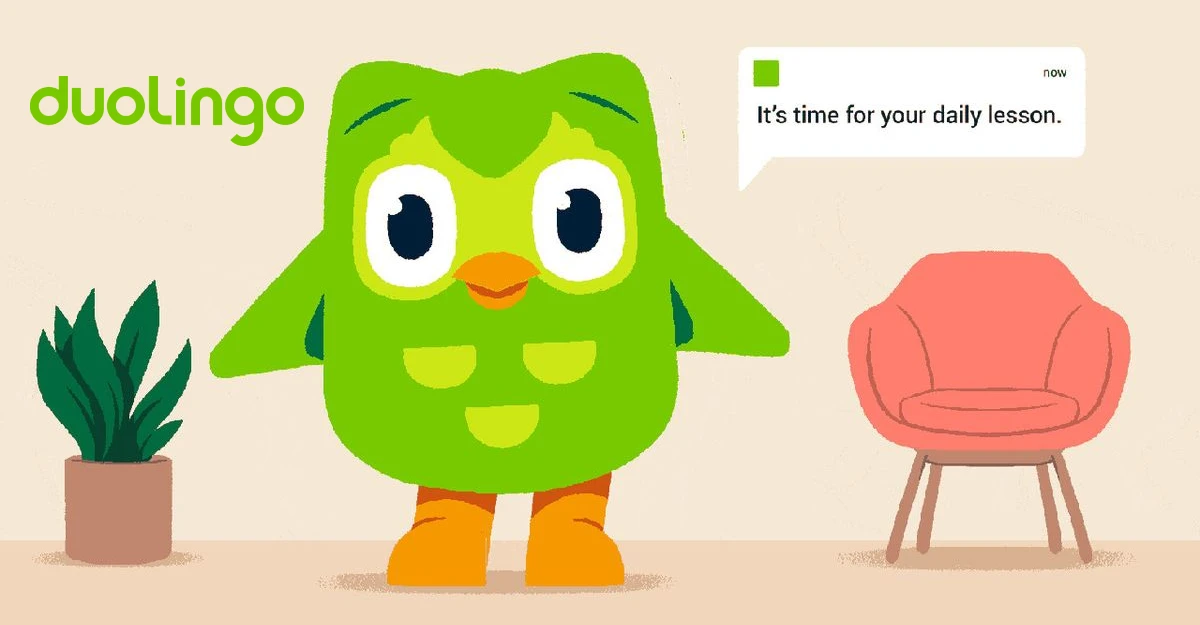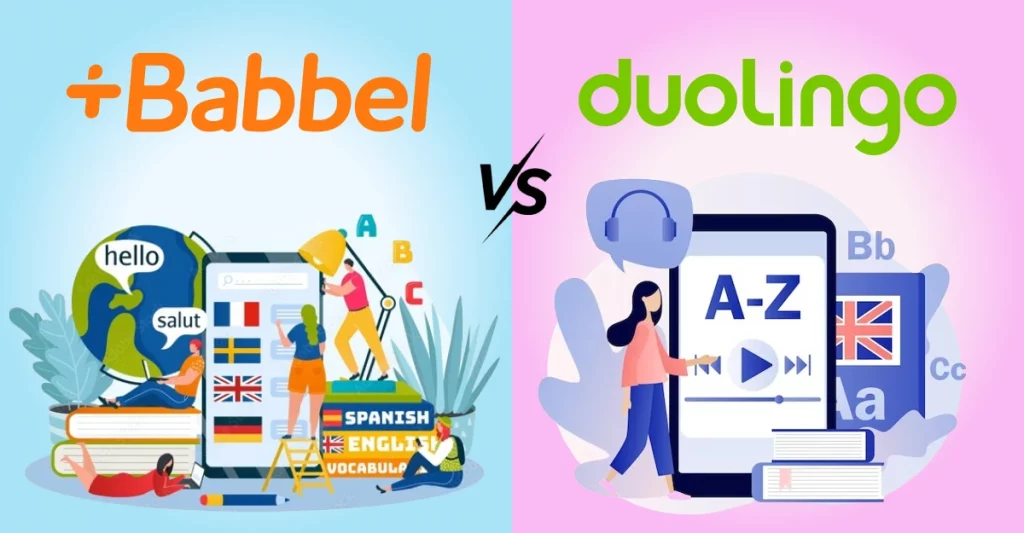Are you wondering which app, Babbel or Duolingo, suits you best in language learning? Both offer tons of languages and cool ways to learn. But picking one can be tricky.

Fear not!
We’re diving deep into the Babbel vs Duolingo debate. From what they teach to how much they cost, we’ve got you covered. By the end, you’ll know which app wins the language learning crown!
Babbel vs Duolingo: A Brief Overview
First of all, let’s have a look at their profiles-
| Particulars | Babbel GmbH | Duolingo Inc. |
| Type of Company | Private | Public |
| Major Languages Available | Danish, Dutch, English, French, German, Indonesian, Italian, Norwegian, Polish, Portuguese, Russian, Spanish, Swedish, Turkish | German, Chinese, Hindi, Arabic, Italian, Spanish, English, Haitian Creole, Japanese, Korean, Russian, Polish, Swedish, Latin |
| Headquarters | Berlin (Germany) | Pennsylvania (United States) |
| Launched | 2007 | 2011 |
| Area Served | Worldwide | Worldwide |
| Key People | Arne Schepker (CEO), Thomas Holl (Co-Founder), Julie Hansen (CEO Babbel, Inc.) | Luis von Ahn (CEO, Founder) Severin Hacker (Founder) |
| Operating Industry | E-Learning, Online Education | Online Education |
| Competitors | Duolingo, Rosetta Stone, Busuu, Memrise | Duoplanet, Babbel, Fluentu, DuoMe |
Before delving further, we will look at both companies individually.
Babbel

Babbel is a language-learning platform from Germany that’s been around since 2008. It’s like a virtual classroom where you can learn different languages from the comfort of your own home. They offer all sorts of resources to help you learn, like apps, live classes, podcasts, and even products for businesses. What’s cool is that they focus on teaching you how to actually use the language in real-life situations, so you can chat with real people and feel confident using what you’ve learned.
They’ve got a huge library of lessons, over 60,000 in fact, covering 14 different languages. Babbel was actually the first of its kind, paving the way for other language-learning platforms. And with over 16 million subscribers, it’s the most popular one out there!
Based in Berlin, Babbel also has an office in New York, with about 1000 employees working hard to help people all over the world learn new languages.
Duolingo

Duolingo is an American company that’s all about making learning fun and easy with its apps. They offer courses on tons of subjects, from languages like English, French, and Spanish to more unique ones like Welsh, Irish, and Swahili. But it’s not just languages—they’ve got lessons on music, math, and more. They even have special apps for kids to learn how to read!
The best part?
Duolingo is free to use, but if you want some extra perks, you can sign up for their premium service, Super Duolingo. This version is ad-free and comes with even more features to help you learn faster.
And it seems like a lot of people love Duolingo—according to a study, it’s the most popular language-learning app in the world, with millions of people downloading it every month. While there haven’t been too many studies on how effective it is, users seem to really enjoy using it and find it helpful for learning new languages.
Features Comparison: Babbel vs Duolingo
Let’s compare their features in detail which will help you decide which language-learning app suits your needs-
| Aspects | Babbel | Duolingo |
| Learning Approach | Structured, practical conversation skills with a traditional approach- Focuses on vocabulary, with lessons organized by themes | Gamified learning experience emphasizing fun and engagement- cover vocabulary, grammar, listening, and speaking exercises |
| Subscription Prices | 1 Month: $99 3 Month: $70 6 Month: $60 12 Month: $50 Lifetime: $299.5 | Super Subscription 1 Month: $12.99 Super Subscription 1 Year: $59.99 Super Family (per Year): $119.99 |
| Content Focus | Real-world content, relevant to daily conversations. | A broad range of topics, including some quirky ones. |
| Lessons Format | Short lessons (around 15 minutes) with interactive drills. | Bite-sized lessons with a game-like feel. |
| Course Organization | Levels (e.g., Newcomer, Beginner I, Intermediate) with thematic topics and courses. | Gamified progression through levels and skills. |
| Teaching Methods | Emphasizes structured learning through dialogues, speech recognition, and grammar explanations | Utilizes gamification and repetition to reinforce learning, with less emphasis on grammar explanations |
| Grammar Instruction | Concise and helpful grammar tips integrated into lessons. | Minimal explicit grammar instruction; learn through context. |
| Review Sessions | Regular review sessions to reinforce material retention. | Adaptive repetition system for reinforcement. |
| Price | Subscription-based (various plans available) | A free version is available, with optional paid features. |
| Number of Languages Offered | Fewer languages compared to Duolingo. | Extensive range of languages |
| Target Audience | Serious learners focusing on one language- Geared towards adults and older learners looking for structured language instruction. | Casual learners dabbling in multiple languages- Appeals to a wide range of learners, including adults and children, with its gamified approach. |
| Offline Access | Provides limited offline access to lessons and materials with a paid subscription | Allows downloading lessons for offline use with a paid subscription. |
Users say that Babbel is ideal for serious learners who want structured instruction and practical conversation skills. Whereas Duolingo suits casual learners who enjoy gamified learning and want exposure to various languages.
By the way, what are your views on this? Don’t forget to share it in the comments!
Business Comparison of Babbel vs Duolingo
In this section, we will compare various business aspects of Babell vs Duolingo to determine which is doing language learning better-
| Business Aspects (FY23) | Babbel | Duolingo |
| Userbase | Over 10 million | Over 575 million |
| Market Capitalization/Market Valuation | $1.5 billion | $8.58 billion |
| Revenue | $270 million (2022) | $531 million |
| Expenses | N/A | $544 million |
| Total Assets | N/A | $954 million |
| Total Equity | N/A | $656 million |
| Profit/Loss | Loss of $25.14 million (2020) | Profit of $16.1 million |
From the table, we can see that Duolingo has a much larger user base compared to Babbel, with over 575 million users, while Babbel has over 10 million users. This suggests that Duolingo is more popular and widely used among language learners.
In terms of market capitalization or market valuation, Duolingo also outperforms Babbel significantly, with a valuation of $8.58 billion compared to Babbel’s $1.5 billion. This indicates that investors value Duolingo more highly as a business.
When it comes to revenue, Duolingo again surpasses Babbel, earning $531 million compared to Babbel’s $270 million in 2022. However, Duolingo also has higher expenses, totaling $544 million, whereas Babbel’s expenses are not provided.
In terms of assets and equity, Duolingo also has higher figures compared to Babbel, indicating a stronger financial position.
Overall, based on the business aspects, Duolingo appears to be performing better in terms of user base, market valuation, revenue, and financial position compared to Babbel.
Ending Note
In the world of language learning, Duolingo emerges as the winner. With a larger user base, higher market valuation, and greater revenue compared to Babbel, Duolingo appears to be doing language learning better. Its popularity and financial strength make it a top choice for language learners worldwide.
Which one is your favorite and why? Share your thoughts in the comment section.


Duolingo appears to be a good choice to consider by looking at its numbers!